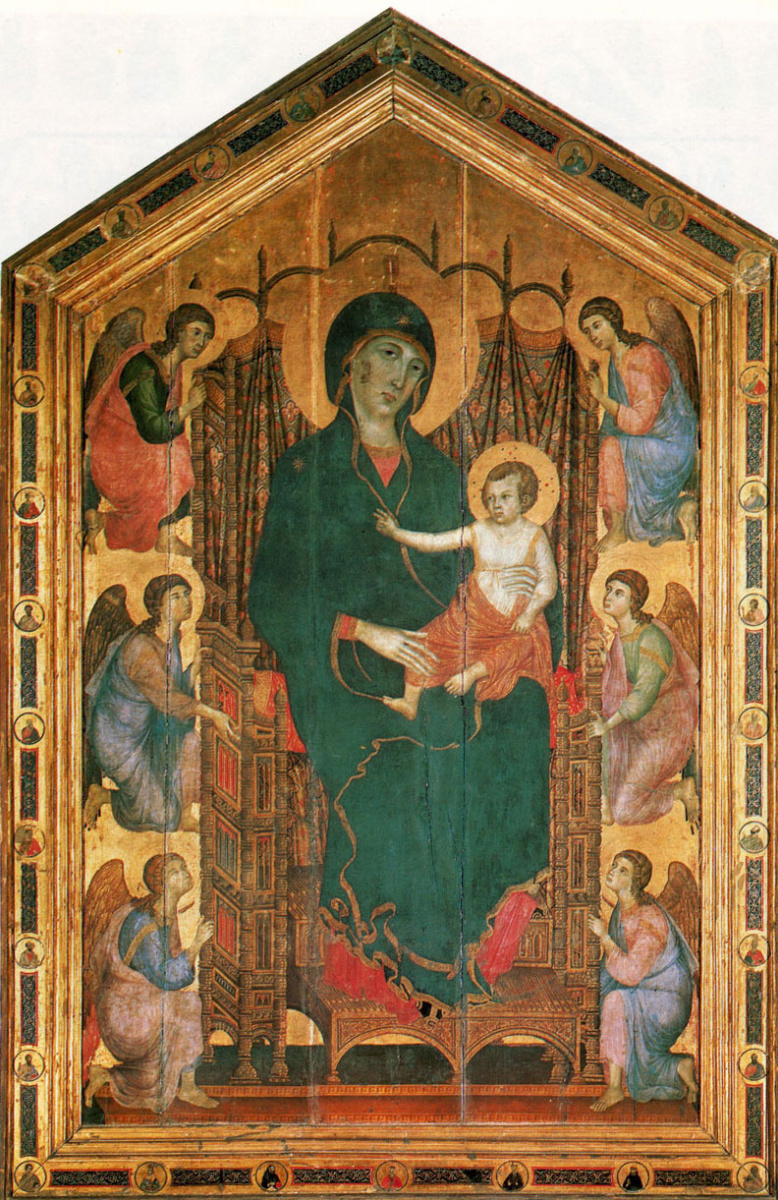log in
Enter site
Login to use Arthive functionality to the maximum
Madonna Rucellai
Duccio di Buoninsegna • Pintura, 1285, 290×450 cm
Descripción del cuadro «Madonna Rucellai»
"Madonna Rucellai" written by Duccio di Buoninsegna in 1285 by order of the Church of Santa Maria Novella (Florence). Your name, the picture has received later the name of the chapel (chapel) Rucellai, where it was moved in the sixteenth century.
The problem of attribution of the "Madonna Rucellai"
For a long time the work was attributed to the Florentine Cimabue. This opinion is shared by even a respected connoisseur of art, like Giorgio Vasari.
The blessing gesture of the Baby and frame shape with a triangular pediment, no doubt, remind "Maesto" Cimabue (Paris, Louvre). But, otherwise, there salpicao (Northern European) influence, is not peculiar to the works of Cimabue. Gothic the brightness and radiance of the colors, the clarity and sonority of color "Madonna Rucellai" is also due to the North-European artistic influence.
The decisive argument in favor of the authorship of Duccio di Buoninsegna was the decoration of the frame of the "Madonna Rucellai". Around the perimeter of the frame, in medallions, are arranged at equal intervals from each other, is a half-length figures of the apostles and the Dominican saints. Their selection, according to the researchers, corresponds to the ideological programme of one of the monastic divisions of the Dominican order – Brotherhood Laudesi encountered in 1244-45. The main task of the Brotherhood saw the fight against the proliferation of heresies, and method of controlling activation of preaching efforts. In his sermons it appealed to the lives of the Dominican saints, many of whom are depicted on the frame of the "Madonna Rucellai". Since there are documents proving that the Brotherhood of Laudesi ordered the painting of Duccio, it is assumed that this is the "Madonna Rucellai".
Artistic features of the "Madonna Rucellai"
Issued on a gold background the virgin and child, seated on a high throne, corresponds to the Byzantine tradition, but the Byzantine style of writing Duccio enriches with elegance and decorative Gothic. Not quite the typical iconography of the painting: the angels are not just coming to Mary and support her throne, as if releasing it from heaven to earth. The lightness and elegance of lines (for example, the soft treatment of the drapery of the angel cloaks and the innovation as the gold fringe on the garment of Mary) also shows a clear influence of French Gothic art. And the side view in which is written the carved throne of the virgin Mary, is a timid hint of overcoming the flatness of the image and the subsequent emergence in the Italian art of linear perspective.
Author: Anna Yesterday
The problem of attribution of the "Madonna Rucellai"
For a long time the work was attributed to the Florentine Cimabue. This opinion is shared by even a respected connoisseur of art, like Giorgio Vasari.
The blessing gesture of the Baby and frame shape with a triangular pediment, no doubt, remind "Maesto" Cimabue (Paris, Louvre). But, otherwise, there salpicao (Northern European) influence, is not peculiar to the works of Cimabue. Gothic the brightness and radiance of the colors, the clarity and sonority of color "Madonna Rucellai" is also due to the North-European artistic influence.
The decisive argument in favor of the authorship of Duccio di Buoninsegna was the decoration of the frame of the "Madonna Rucellai". Around the perimeter of the frame, in medallions, are arranged at equal intervals from each other, is a half-length figures of the apostles and the Dominican saints. Their selection, according to the researchers, corresponds to the ideological programme of one of the monastic divisions of the Dominican order – Brotherhood Laudesi encountered in 1244-45. The main task of the Brotherhood saw the fight against the proliferation of heresies, and method of controlling activation of preaching efforts. In his sermons it appealed to the lives of the Dominican saints, many of whom are depicted on the frame of the "Madonna Rucellai". Since there are documents proving that the Brotherhood of Laudesi ordered the painting of Duccio, it is assumed that this is the "Madonna Rucellai".
Artistic features of the "Madonna Rucellai"
Issued on a gold background the virgin and child, seated on a high throne, corresponds to the Byzantine tradition, but the Byzantine style of writing Duccio enriches with elegance and decorative Gothic. Not quite the typical iconography of the painting: the angels are not just coming to Mary and support her throne, as if releasing it from heaven to earth. The lightness and elegance of lines (for example, the soft treatment of the drapery of the angel cloaks and the innovation as the gold fringe on the garment of Mary) also shows a clear influence of French Gothic art. And the side view in which is written the carved throne of the virgin Mary, is a timid hint of overcoming the flatness of the image and the subsequent emergence in the Italian art of linear perspective.
Author: Anna Yesterday


